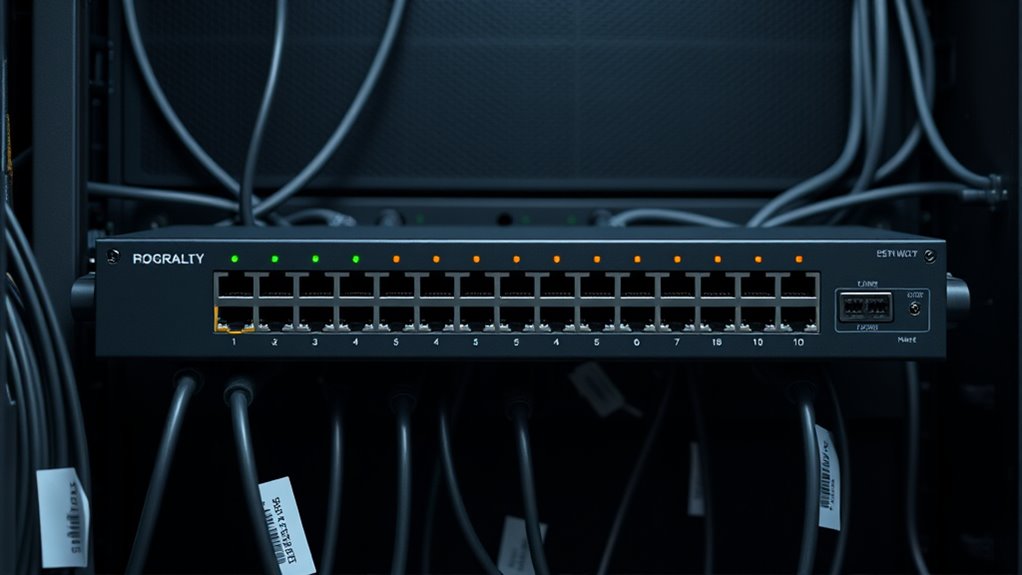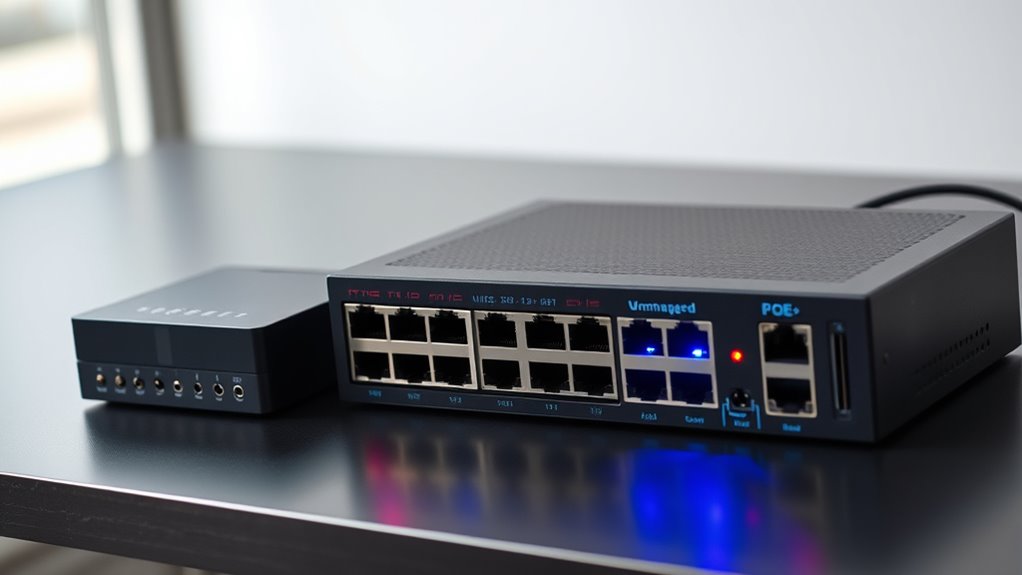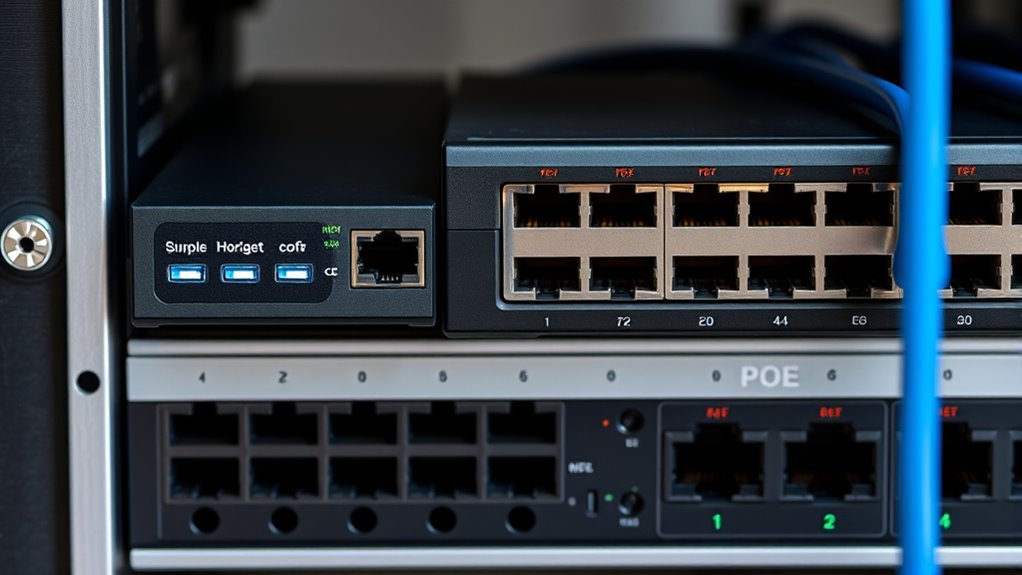When choosing between unmanaged, managed, and PoE switches, you need to take into account your network’s complexity and future needs. Unmanaged switches are simple and perfect for small setups, while managed switches offer advanced control, security, and scalability for larger or more complex networks. PoE switches add convenience by supplying power through Ethernet cables, ideal for devices like cameras and phones. To find out which switch fits your environment best, keep exploring the details ahead.
Key Takeaways
- Unmanaged switches are simple, plug-and-play devices ideal for small networks with minimal configuration needs.
- Managed switches offer advanced features like VLANs, security controls, and real-time monitoring for complex or enterprise environments.
- PoE switches combine data transfer with power delivery, enabling devices like IP cameras and phones to operate over a single cable.
- The choice depends on network size, security requirements, scalability, and whether advanced management features are necessary.
- Industrial settings favor managed switches for ruggedness and control, while small offices often use unmanaged switches for simplicity.
Overview of Network Switches

Network switches are vital devices that connect multiple devices within a local area network (LAN), enabling efficient data transfer. They manage traffic by directing data packets to specific devices, which improves network performance. Managed switches offer features like VLAN segmentation, allowing you to divide your network into separate virtual segments for better security and traffic management. Regular firmware updates are essential for maintaining switch security, fixing bugs, and enhancing features. These updates ensure your switch operates smoothly and stays protected against vulnerabilities. Understanding the basics of network switches helps you choose the right type for your needs, whether you’re looking for simple connectivity or advanced management capabilities. Properly configuring VLANs and keeping firmware current maximizes your network’s efficiency and security.
Characteristics of Unmanaged Switches

Unmanaged switches are known for their simple setup process, making them ideal for quick installations. You won’t have many configuration options to tweak, which keeps things straightforward. This simplicity is perfect if you want reliable network connections without complex management. Additionally, their ease of maintenance makes them suitable for environments where minimal oversight is preferred. Their cost-effectiveness also makes unmanaged switches a popular choice for small-scale or temporary network setups. Furthermore, they are commonly used in Kia Tuning setups where straightforward connectivity is essential. For those seeking to avoid scams and ensure secure investments, unmanaged switches provide a dependable, low-maintenance solution.
Simple Setup Process
Because they don’t require complex configuration, unmanaged switches are known for their straightforward setup process. You can simply plug and play, making installation quick and hassle‑free. There’s no need to navigate confusing menus or adjust settings, which minimizes potential errors. This simplicity allows you to focus on connecting devices without worry. Imagine the relief of getting your network going instantly, instead of wasting time on technical tweaks. With an unmanaged switch, you get peace of mind knowing that setup is as easy as connecting cables. plug and play technology ensures a seamless installation experience, even for beginners. Vetted materials ensure durability and reliability, contributing to a smooth installation experience. Additionally, their reliable performance reduces troubleshooting time, making them ideal for straightforward network setups.
Limited Configuration Options
While unmanaged switches are praised for their simplicity, they offer limited configuration options. You won’t find features like VLAN setup, traffic prioritization, or advanced security controls. This means your configuration flexibility is minimal, and you can’t customize the switch’s behavior beyond basic connectivity. If you need specific network segments or traffic management, unmanaged switches won’t support those needs. Their customization limitations make them ideal for straightforward setups but less suitable for complex or evolving networks. You won’t be able to adjust settings to optimize performance or enhance security, which can be a drawback in more demanding environments. Ultimately, unmanaged switches prioritize ease of use over advanced features, making them a good choice for simple networks but restrictive if you require more control. Additionally, they lack security features that are often necessary for protecting sensitive data.
Features of Managed Switches

Managed switches offer advanced network management capabilities that let you control and optimize your network more effectively. They also provide enhanced security features to protect your data and prevent unauthorized access. Understanding these features helps you choose the right switch to meet your network’s needs. For example, residency requirements play a crucial role in determining the appropriate switch type for your setup. Additionally, features like network segmentation help improve performance and security by isolating different parts of your network. Implementing proper configuration ensures optimal operation and safeguards against potential vulnerabilities. Incorporating real-time monitoring allows for proactive management and quick troubleshooting of network issues.
Advanced Network Management
Advanced network management features in managed switches enable you to control and optimize your network with greater precision. With capabilities like network automation, you can streamline routine tasks, reduce errors, and save time. Regularly updating switch firmware guarantees your system stays secure and performs efficiently. These features give you real-time monitoring, helping you identify issues before they impact your network. You gain granular control over traffic flow, prioritizing critical data. You can also customize configurations to fit your unique needs, boosting overall performance. Plus, detailed logs and alerts keep you informed, making troubleshooting faster. Implementing these advanced features also supports sustainable practices by optimizing energy use and reducing waste. Understanding operating hours of your network components is crucial for maintaining efficiency and avoiding downtime. – Feel empowered to manage your network effortlessly – Experience seamless performance and reliability – Reduce downtime with proactive monitoring – Achieve peace of mind knowing your network is secure – Access the full potential of your infrastructure
Enhanced Security Features
Enhanced security features in managed switches are essential for protecting your network from threats and unauthorized access. You can implement intrusion detection to monitor suspicious activity and prevent breaches. Access control allows you to restrict device connections, ensuring only authorized users get network access. These features help you maintain a secure environment and reduce vulnerabilities. Additionally, regulatory compliance is increasingly important, requiring security measures to meet legal standards. Employing security protocols further fortifies your network defenses against evolving cyber threats. Implementing encryption standards ensures data confidentiality during transmission and storage, adding another layer of security in your network infrastructure. Incorporating identity management capabilities can further enhance control over network access and user activities.
Understanding Power Over Ethernet (Poe) Switches

Power over Ethernet (PoE) switches simplify network setups by delivering both data and electrical power through a single Ethernet cable. This integration streamlines installation, reduces clutter, and cuts costs. PoE relies on specific Ethernet standards, like IEEE 802.3af and 802.3at, to guarantee safe and reliable power delivery. When selecting a PoE switch, you open the potential for flexible device placement without nearby power outlets. Imagine the convenience of connecting security cameras, VoIP phones, or wireless access points effortlessly.
PoE switches enable easy, cost-effective network connections with reliable power over a single Ethernet cable.
- Feel empowered with easier, cleaner installations
- Experience seamless device connectivity
- Enjoy reliable power delivery without extra wiring
- Reduce infrastructure costs considerably
- Achieve scalable, future-proof networks
Comparing Use Cases and Environments

Choosing the right type of network switch depends heavily on the specific use case and environment. For industrial environments, managed switches are ideal because they offer advanced control, monitoring, and security features necessary for complex systems. They can withstand harsh conditions and guarantee reliable connectivity for manufacturing, automation, or critical infrastructure. They are often equipped with robust build quality to endure challenging conditions. In contrast, unmanaged switches suit simple setups with minimal management needs, like small offices or home networks. When it comes to home automation, unmanaged switches provide plug-and-play simplicity for connecting smart devices without extra configuration. However, if you have a more extensive smart home system, a managed switch may offer better flexibility, security, and future scalability. Understanding these environments helps you choose a switch that aligns with your technical requirements and operational demands. Network security is also a crucial factor to consider when selecting the appropriate switch for your environment. Additionally, selecting a switch with features like power management can enhance energy efficiency and reduce operational costs in various settings. Incorporating proper ventilation can also extend the lifespan of switches in high-temperature settings, ensuring consistent performance over time.
Making the Right Choice for Your Network

Selecting the right network switch starts with understanding your specific needs and the environment in which it will operate. Think about your future growth, whether you need wireless scalability or fiber optic compatibility to handle high-speed data demands. Consider these factors to make an informed choice:
Choosing the right network switch depends on your current needs and future growth plans.
- Expandability to support new devices without hassle
- Seamless integration with your existing infrastructure
- Reliable performance under load
- Easy management and troubleshooting
- Compatibility with fiber optics for faster connections
- Utilizing industry trends can help you stay ahead in network technology advancements and ensure your network remains efficient and scalable in the long run.
Frequently Asked Questions
How Do Switch Prices Vary Across Different Types?
Switch prices vary considerably across types. Managed switches tend to be more expensive due to advanced features and customization options, while unmanaged switches are generally cheaper, suitable for simple setups. Poe switches, which include power over Ethernet, usually fall in between, with added costs for power delivery. When considering cost considerations, think about your network needs—spending more on managed or Poe switches can offer better control and future scalability.
Can Unmanaged Switches Be Upgraded to Managed Switches Later?
Unmanaged switches generally can’t be upgraded to managed switches later due to their hardware limitations. Switch upgradeability is limited because unmanaged switches lack the necessary software and hardware features for management functions. If you need managed capabilities in the future, it’s better to choose a switch designed for scalability now, as unmanaged switches have inherent limitations that prevent upgrades later. This ensures you won’t face compatibility or performance issues down the line.
What Security Features Are Exclusive to Managed Switches?
Managed switches offer exclusive security features like VLAN segmentation and port security, which unmanaged switches lack. VLAN segmentation helps you isolate network traffic for better security and performance, while port security restricts access to authorized devices. These features give you greater control over your network, reducing vulnerabilities. By managing your switch settings, you can better protect sensitive data and prevent unauthorized access, ensuring your network stays secure and efficient.
How Does Poe Affect Network Bandwidth and Performance?
PoE can slightly affect your network bandwidth and performance because it uses power delivery over Ethernet cables, which may introduce network interference. This interference can cause minor data transmission issues, especially if cables aren’t well-shielded. However, modern switches manage power efficiently, so the impact is usually minimal. You might notice some slowdown if multiple devices draw high power simultaneously, but overall, PoE generally maintains reliable network performance.
Are There Eco-Friendly or Energy-Efficient Switch Options Available?
Yes, you can find eco-friendly or energy-efficient switches that feature energy-saving options and are made from eco-friendly materials. These switches automatically reduce power consumption during low activity periods, helping you save energy. Look for models with energy-saving features like port management and eco-friendly construction, which minimize environmental impact. Choosing these switches helps you lower your carbon footprint while maintaining reliable network performance.
Conclusion
Choosing the right switch depends on your network needs. Managed switches offer advanced control, while unmanaged switches are simple and cost-effective. PoE switches power devices like cameras easily, saving you time and equipment costs. Did you know that by 2025, over 75% of network switches will support PoE, reflecting its growing importance? Understanding these options helps you build a reliable, scalable network tailored to your environment’s demands.









